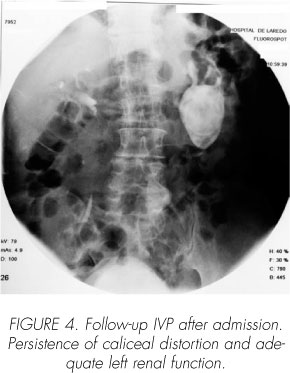My SciELO
Services on Demand
Journal
Article
Indicators
-
 Cited by SciELO
Cited by SciELO -
 Access statistics
Access statistics
Related links
-
 Cited by Google
Cited by Google -
 Similars in
SciELO
Similars in
SciELO -
 Similars in Google
Similars in Google
Share
Archivos Españoles de Urología (Ed. impresa)
Print version ISSN 0004-0614
Arch. Esp. Urol. vol.62 n.5 Jun. 2009
Giant pielic lithiasis of bening evolution
Litiasis piélica gigante de evolución "benigna"
Miguel Ángel Rado-Velazquez, Enrique de Diego Rodríguez, Alberto Hernández Castrillo and José Manuel Lanzas Prieto.
Department of Urology. Hospital Comarcal de Laredo, Cantabria. Spain.
A 81 years old patient is seen in the Emergency Department complaining of left flank pain and fever. A giant calcification (7.2 x 6 cm) is seen over the left renal shadow, along with multiple vesical lithiases in plain abdominal radiography (Figure 1). A double-J catheter could not be inserted, but the vesical lithiases were successfully extracted.

Empiric antibiotic treatment was initiated after obtaining blood cultures and a vesical lithiasis culture. Patient response to treatment was satisfactory, therefore, the patient was discharged, asymptomathic, three days later from the hospital. Blood and vesical lithiasis cultures yielded Staph Aureus which were sensitive to the antibiotics utilised. Nine years ago, the same patient was seen in an office consultation with a left pyelic lithiasis of 4.5 x 4.5 cm (Figure 2). A pyelogram was requested, but the patient did not return for subsequent check-ups. The initial IVP (Figure 3) demonstrates adequate left renal function with probable UPJ syndrome. In the follow-up IVP after admission (Figure 4), adequate left renal function persists with calyceal distortion and a giant pyelic lithiasis was observed. Due to patient's age, adequate renal function of the affected area and the lack of symptoms, a wait and see attitude was taken. Since hospital discharge, more than a year ago, no treatment has been necessary.



 Correspondence:
Correspondence:
Miguel
Ángel Rado Velázquez
Avda de Santander 6A. Chalet 5
Urbanización Las Camelias.
39600 Muriedas. Cantabria. (Spain)
maradove@gmail.com











 text in
text in 


